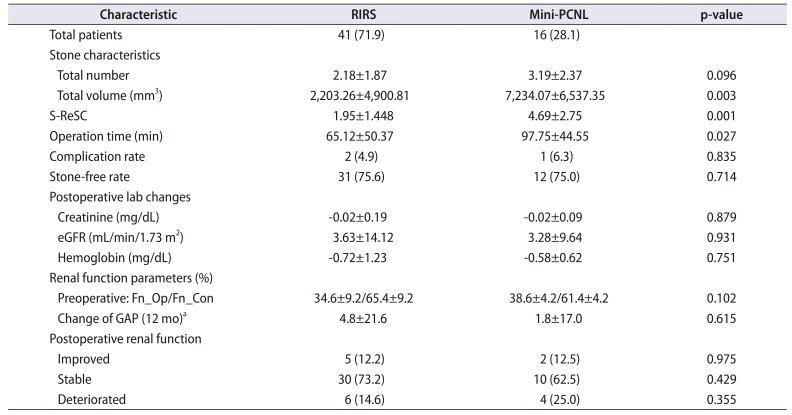1. Marchini GS, Vicentini FC, Mazzucchi E, Brito A, Ebaid G, Srougi M. Silent ureteral stones: impact on kidney function--can treatment of silent ureteral stones preserve kidney function? Urology. 2012; 79:304–308. PMID:
22055694.

2. Alexander RT, Hemmelgarn BR, Wiebe N, Bello A, Morgan C, Samuel S, et al. Alberta Kidney Disease Network. Kidney stones and kidney function loss: a cohort study. BMJ. 2012; 345:e5287. PMID:
22936784.

3. Assimos D, Krambeck A, Miller NL, Monga M, Murad MH, Nelson CP, et al. Surgical management of stones: American Urological Association/Endourological Society Guideline, part I. J Urol. 2016; 196:1153–1160. PMID:
27238616.

4. Gupta M, Bolton DM, Gupta PN, Stoller ML. Improved renal function following aggressive treatment of urolithiasis and concurrent mild to moderate renal insufficiency. J Urol. 1994; 152:1086–1090. PMID:
8072069.

5. Gambaro G, Favaro S, D'Angelo A. Risk for renal failure in nephrolithiasis. Am J Kidney Dis. 2001; 37:233–243. PMID:
11157364.

6. Kirac M, Bozkurt ÖF, Tunc L, Guneri C, Unsal A, Biri H. Comparison of retrograde intrarenal surgery and mini-percutaneous nephrolithotomy in management of lower-pole renal stones with a diameter of smaller than 15 mm. Urolithiasis. 2013; 41:241–246. PMID:
23483226.
7. Lee JW, Park J, Lee SB, Son H, Cho SY, Jeong H. Mini-percutaneous nephrolithotomy vs retrograde intrarenal surgery for renal stones larger than 10 mm: a prospective randomized controlled trial. Urology. 2015; 86:873–877. PMID:
26320082.
8. Bilen CY, Inci K, Kocak B, Tan B, Sarikaya S, Sahin A. Impact of percutaneous nephrolithotomy on estimated glomerular filtration rate in patients with chronic kidney disease. J Endourol. 2008; 22:895–900. PMID:
18393644.

9. Piao S, Park J, Son H, Jeong H, Cho SY. Evaluation of renal function in patients with a main renal stone larger than 1 cm and perioperative renal functional change in minimally invasive renal stone surgery: a prospective, observational study. World J Urol. 2016; 34:725–732. PMID:
26226940.
10. El-Nahas AR, Eraky I, Shokeir AA, Shoma AM, El-Assmy AM, El-Tabey NA, et al. Long-term results of percutaneous nephrolithotomy for treatment of staghorn stones. BJU Int. 2011; 108:750–754. PMID:
21166763.

11. Canes D, Hegarty NJ, Kamoi K, Haber GP, Berger A, Aron M, et al. Functional outcomes following percutaneous surgery in the solitary kidney. J Urol. 2009; 181:154–160. PMID:
19013616.

12. Levey AS, Coresh J, Balk E, Kausz AT, Levin A, Steffes MW, et al. National Kidney Foundation. National Kidney Foundation practice guidelines for chronic kidney disease: evaluation, classification, and stratification. Ann Intern Med. 2003; 139:137–147. PMID:
12859163.

13. Jeong CW, Jung JW, Cha WH, Lee BK, Lee S, Jeong SJ, et al. Seoul National University Renal Stone Complexity score for predicting stone-free rate after percutaneous nephrolithotomy. PLoS One. 2013; 8:e65888. PMID:
23824752.

14. Dindo D, Demartines N, Clavien PA. Classification of surgical complications: a new proposal with evaluation in a cohort of 6336 patients and results of a survey. Ann Surg. 2004; 240:205–213. PMID:
15273542.
15. Cho SY, Kim IS, Lee SB, Choi H, Park K. Nature and fate of supranormal differential renal function: lessons from long-term follow-up after pyeloplasty. Urology. 2013; 81:163–167. PMID:
23200971.

16. Akman T, Binbay M, Kezer C, Yuruk E, Tekinarslan E, Ozgor F, et al. Factors affecting kidney function and stone recurrence rate after percutaneous nephrolithotomy for staghorn calculi: outcomes of a long-term followup. J Urol. 2012; 187:1656–1661. PMID:
22425085.

17. Pérez-Fentes D, Cortés J, Gude F, García C, Ruibal A, Aguiar P. Does percutaneous nephrolithotomy and its outcomes have an impact on renal function? Quantitative analysis using SPECT-CT DMSA. Urolithiasis. 2014; 42:461–467. PMID:
25074714.

18. Kukreja R, Desai M, Patel SH, Desai MR. Nephrolithiasis associated with renal insufficiency: factors predicting outcome. J Endourol. 2003; 17:875–879. PMID:
14744353.

19. Agrawal MS, Aron M, Asopa HS. Endourological renal salvage in patients with calculus nephropathy and advanced uraemia. BJU Int. 1999; 84:252–256. PMID:
10468716.

20. Unsal A, Koca G, Reşorlu B, Bayindir M, Korkmaz M. Effect of percutaneous nephrolithotomy and tract dilatation methods on renal function: assessment by quantitative single-photon emission computed tomography of technetium-99mdimercaptosuccinic acid uptake by the kidneys. J Endourol. 2010; 24:1497–1502. PMID:
20649443.
21. Handa RK, Evan AP, Willis LR, Johnson CD, Connors BA, Gao S, et al. Renal functional effects of multiple-tract percutaneous access. J Endourol. 2009; 23:1951–1956. PMID:
19909077.

22. Moskovitz B, Halachmi S, Sopov V, Burbara J, Horev N, Groshar D, et al. Effect of percutaneous nephrolithotripsy on renal function: assessment with quantitative SPECT of (99m)Tc-DMSA renal scintigraphy. J Endourol. 2006; 20:102–106. PMID:
16509791.

23. Hoarau N, Martin F, Lebdai S, Chautard D, Culty T, Azzouzi AR, et al. Impact of retrograde flexible ureteroscopy and intracorporeal lithotripsy on kidney functional outcomes. Int Braz J Urol. 2015; 41:920–926. PMID:
26689517.








 PDF
PDF ePub
ePub Citation
Citation Print
Print




 XML Download
XML Download